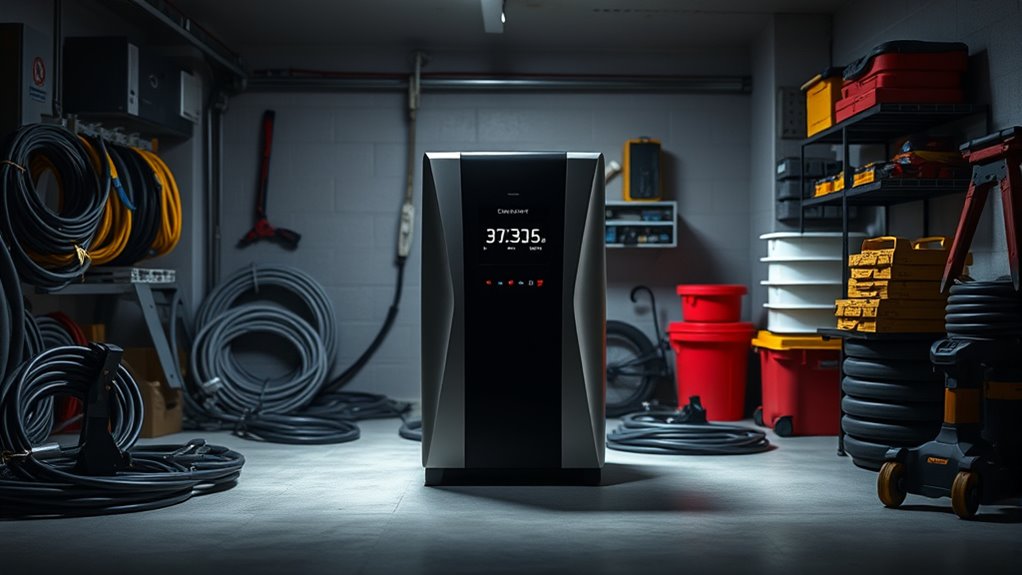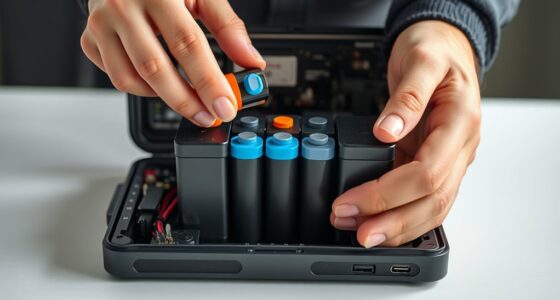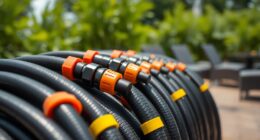When the lights go out unexpectedly, a home backup power station keeps your essential appliances running smoothly. These systems can be portable generators, battery-based storage, or whole-home solutions, often integrated with solar power for efficiency. They help maintain household function, improve emergency preparedness, and enhance grid independence. Selecting the right system depends on your power needs, size, and safety considerations. Keep exploring to learn how to choose the best backup solution for your home.
Key Takeaways
- Home backup power stations provide reliable electricity during outages, often integrating solar energy for sustainability.
- Different types include whole-home systems, portable generators, and battery storage, each with unique features and setup needs.
- Key considerations include power capacity, runtime, device compatibility, portability, and safety during installation and use.
- Modern systems are scalable, allowing expansion to meet growing energy needs and incorporate advanced options like renewable sources.
- Proper installation, maintenance, and safety practices ensure reliable operation and safeguard household and environmental safety.
Understanding Home Backup Power Stations

Have you ever experienced a power outage and wished you had a reliable backup? Home backup power stations are designed to provide that security, often integrating solar power for added efficiency. Solar integration allows your system to harness sunlight, reducing reliance on the grid and promoting grid independence. With a backup station, you can store excess solar energy during the day and use it when the power goes out. This setup ensures continuous electricity, even if the main grid fails. Plus, many modern backup stations are scalable, fitting your energy needs and expanding as necessary. By understanding how these systems work, you can make smarter choices to keep your home powered, save on energy costs, and reduce your carbon footprint. Incorporating battery technologies into your backup plan can further enhance performance and longevity of your energy storage system.
Types of Backup Power Solutions for Homes
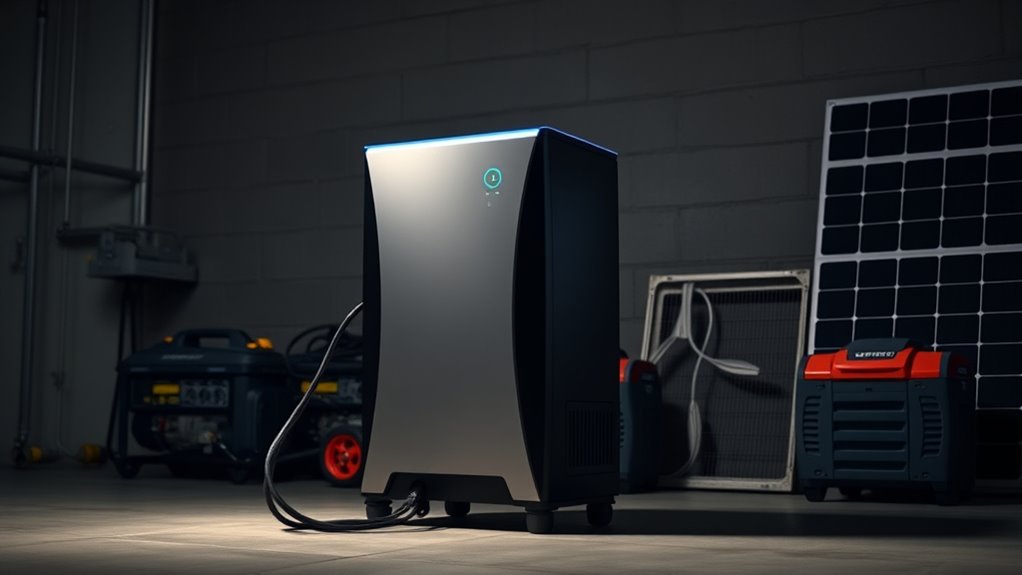
When considering backup power solutions for your home, it’s important to recognize the various options available to meet your specific needs. You can choose between whole-home systems, portable generators, or solar integration units. Whole-home backups offer grid independence and seamless switching, ideal for full coverage. Portable generators are flexible but require manual operation. Solar backup solutions harness sunlight, providing sustainable power and potential grid independence when paired with batteries. Additionally, Kia Tuning modifications can enhance vehicle performance and aesthetics, which could be useful during power outages for mobility or support.
How Do Portable Generators Work?
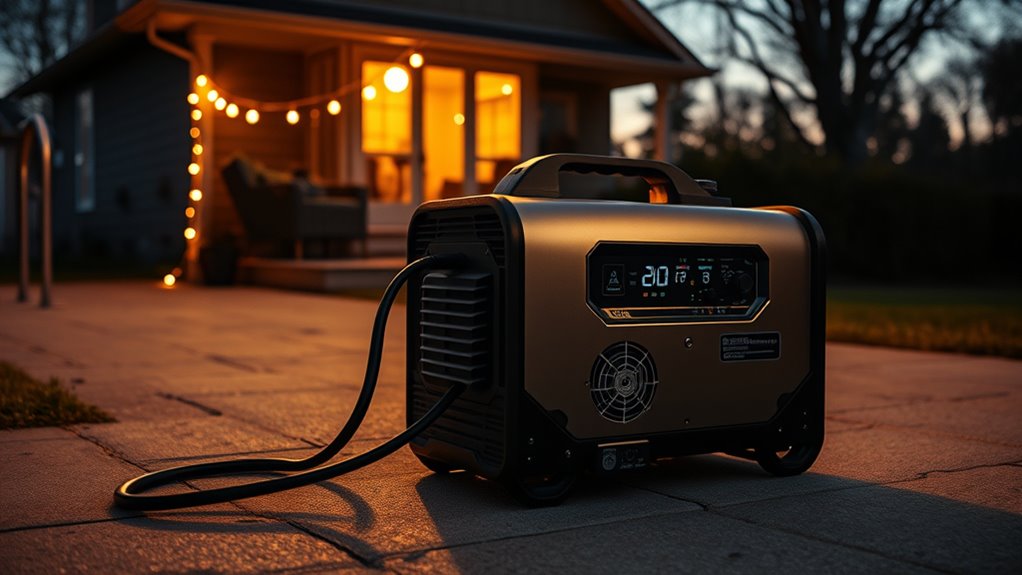
Portable generators operate by converting fuel, such as gasoline or propane, into electrical energy through an engine and alternator. When you start the generator, the engine burns fuel to produce mechanical energy, which drives the alternator to generate electricity. To keep it running smoothly, you’ll need to consider fuel efficiency—choosing models that maximize output while minimizing fuel consumption helps save money and extend runtime. Regular maintenance requirements, like oil changes, filter replacements, and spark plug checks, are essential to ensure reliable operation. Proper upkeep prevents breakdowns and prolongs the life of your generator. By understanding how these units work and staying on top of maintenance, you ensure your portable generator provides dependable backup power when you need it most.
Battery-Based Home Energy Storage Systems

When choosing a battery-based home energy storage system, you need to consider its capacity and power output to meet your energy needs. Proper installation is essential for safety and efficiency, so professional setup is highly recommended. Understanding these points helps you select a reliable system that keeps your home powered safely during outages. Additionally, evaluating the storage capacity ensures that your system can handle your household’s energy demands over time.
Battery Capacity and Power
Battery capacity and power are crucial factors in choosing a home energy storage system because they determine how much energy you can store and how quickly you can draw power when needed. A larger capacity means you can store more energy for longer outages, while higher power output allows you to run multiple appliances simultaneously. Keep in mind that your battery’s longevity depends on its charge cycles—the number of complete charge and discharge cycles it can handle before performance declines. Batteries with more charge cycles tend to last longer, offering better value over time. Understanding these factors helps you select a system that provides reliable backup power while maintaining excellent battery health. Balancing capacity and power is essential to meet your energy needs without sacrificing durability.
Installation and Safety
Installing a battery-based home energy storage system requires careful planning to guarantee safety and reliability. You should work with qualified professionals to assure proper installation, including secure wiring and ventilation. Always follow manufacturer guidelines to prevent hazards. Regular generator maintenance is essential, especially if you rely on backup generators during outages. This keeps your emergency preparedness intact and avoids unexpected failures. Use the table below to understand key safety considerations:
| Safety Tip | Explanation |
|---|---|
| Proper Ventilation | Prevents overheating and gas buildup |
| Professional Installation | Ensures code compliance and safety |
| Routine Maintenance | Keeps system ideal and safe |
| Emergency Access | Easy access for quick shut-off during issues |
| Battery Storage Safety | Proper handling and placement reduce fire risks |
Prioritize safety to protect your home and loved ones during power disruptions.
Key Features to Consider When Choosing a Backup Power Station
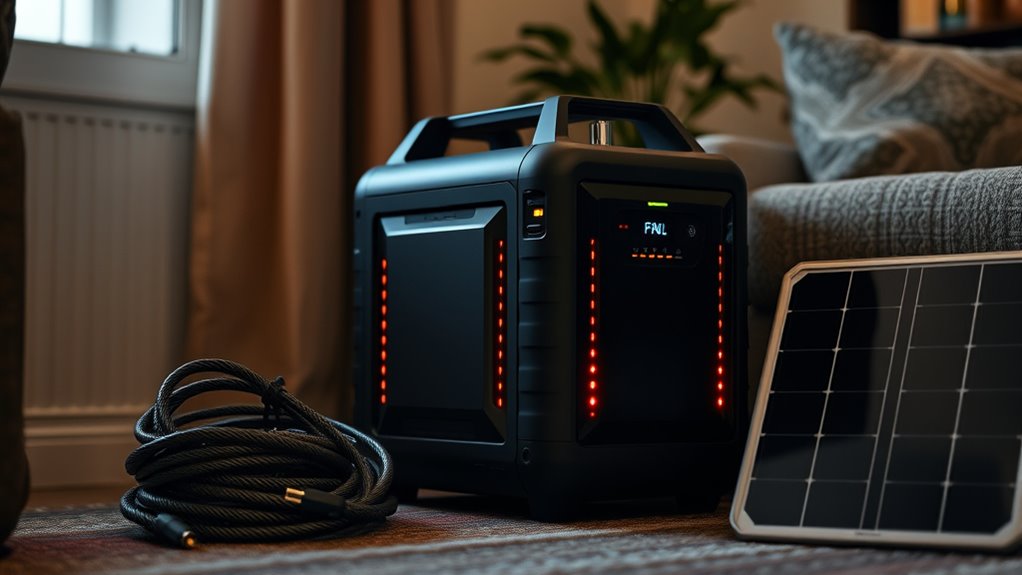
When choosing a backup power station, you need to consider its power capacity and how long it can run during an outage. Think about the types and number of ports it offers to connect your essential devices easily. Also, assess its size and portability to ensure it fits your space and mobility needs. To ensure reliable performance, review best-rated options and consumer feedback for the model you select.
Power Capacity and Runtime
Choosing a backup power station with the right power capacity and runtime guarantees your essential devices stay operational during outages. Power capacity determines how much energy the station can store, influencing how many devices you can run simultaneously. Runtime indicates how long these devices can stay powered before needing a recharge or refueling. To select wisely, consider your typical power needs and outage duration. User privacy policies and cookie preferences may also influence your experience with related online tools and resources.
- Ensure the power capacity matches your critical devices’ wattage requirements
- Longer runtime provides peace of mind during extended outages
- Balance size and portability with your power demands
- Think about future needs as your energy consumption evolves
- Remember, higher capacity often means increased cost and size
Matching capacity and runtime to your needs ensures reliable backup without unnecessary expense.
Port Selection and Types
Ever wondered which ports are essential for your backup power station? The right port selection guarantees you can connect your devices efficiently. Look for outlet compatibility, meaning the station offers different port types like AC outlets, USB-A, USB-C, or even DC outputs. These variations allow you to power everything from laptops to smartphones and small appliances. Consider the port types available and whether they match your device needs. Some stations offer multiple USB ports or specialized connections, making setup more flexible. Ensure the ports support the necessary wattage and voltage for your devices. The best backup power stations provide a variety of port options, so you’re prepared for any power outage scenario without sacrificing convenience or compatibility. Additionally, assessing the port versatility helps ensure the station can accommodate future device upgrades or additional appliances.
Portability and Size
A backup power station’s portability and size are essential factors that determine how easily you can carry and store it during emergencies. A portable design with a compact size allows you to move it effortlessly, whether you’re using it at home or on the go. Smaller units are perfect for limited storage space and quick deployment. Consider these aspects to find the right fit:
- Lightweight construction for easy handling
- Carrying handles or wheels for mobility
- Slim profile to save storage space
- Battery capacity aligned with your power needs
- Durability for outdoor or rugged use
- Incorporating compact design principles can enhance ease of use and storage efficiency.
Choosing a backup power station with a portable design means you’ll have power when you need it most, without sacrificing convenience or space. Opt for a compact size that balances power with ease of transport.
Benefits of Installing a Home Backup Power System

Installing a home backup power system offers significant peace of mind by ensuring your household remains functional during power outages. It enhances your grid independence, so you’re less reliant on the utility company and can continue daily activities uninterrupted. This setup also boosts your emergency preparedness, allowing you to manage unexpected disruptions more effectively. With a backup system, you can keep essential appliances running, maintain safety, and stay connected with loved ones. It’s a proactive step toward safeguarding your home and loved ones from the inconvenience and potential dangers of power failures. Reliable power delivery is a key benefit of installing a backup power station, providing stability, control, and confidence when the lights go out.
Installation and Safety Tips
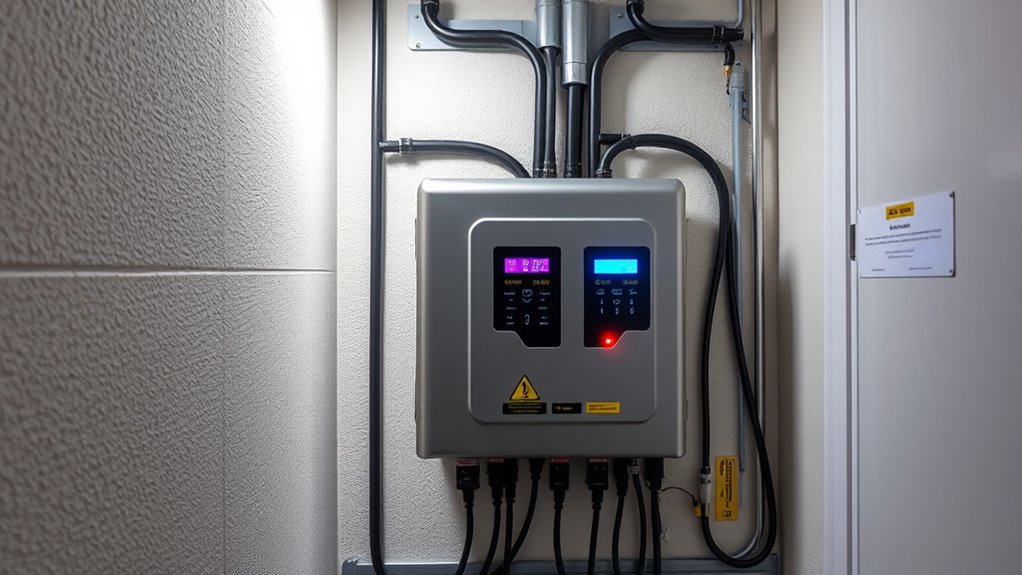
Proper installation and adherence to safety guidelines are vital to guarantee your home backup power system operates reliably and securely. You should always follow manufacturer instructions and consult a professional electrician for proper setup. Make certain your system is installed in a well-ventilated area, away from flammable materials. When integrating the backup power station, consider how it impacts your lighting design and interior decor—placing it discreetly enhances aesthetics without compromising safety. Regularly inspect connections and test the system to prevent malfunctions during outages. Keep fire extinguishers nearby and clearly mark the system’s emergency shut-off switch. Properly grounding the unit minimizes electrical hazards. Additionally, understanding electrical safety practices ensures ongoing protection for your home. Remember, safety isn’t just about compliance—it’s about protecting your home and loved ones during power disruptions.
Making the Right Choice for Your Home Needs
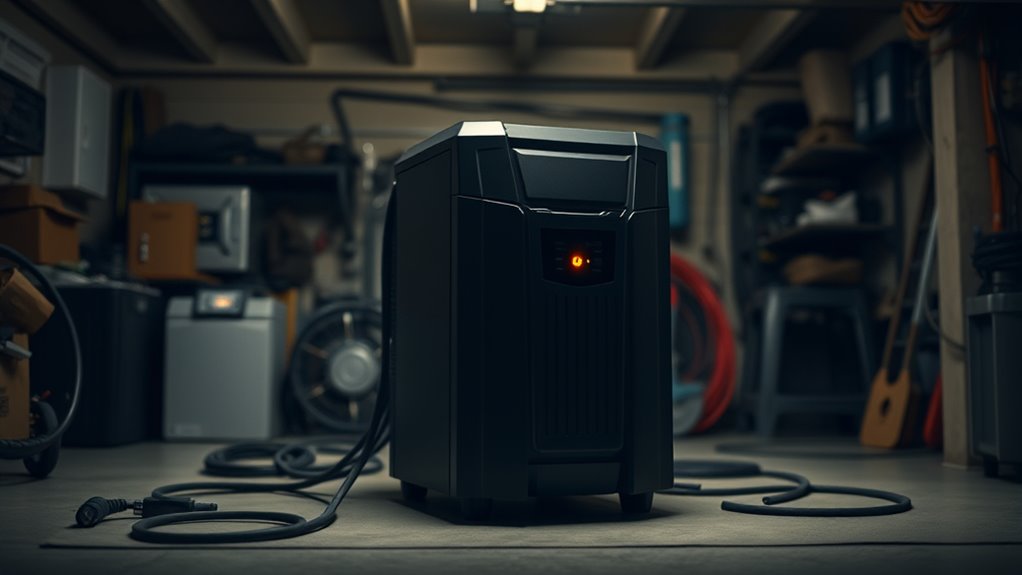
Choosing the right backup power station depends on your home’s specific energy needs, budget, and intended use during outages. If you want a sustainable option, consider models with solar integration, allowing you to harness renewable sources like sunlight. This can reduce reliance on grid power and lower long-term costs. Assess your essential appliances and how long you need backup power to determine capacity requirements. If portability is important, select a lightweight, compact unit; for whole-home backup, a larger station might be necessary. Keep in mind your budget, but also factor in future upgrades or renewable energy expansion. Incorporating commercial-grade heat pumps into your home’s energy plan can improve overall efficiency and provide additional backup heating and cooling options. Making an informed choice guarantees you’re prepared, whether during storms or blackouts, and can confidently rely on your backup power station when you need it most.
Frequently Asked Questions
How Long Can a Backup Power Station Supply Electricity During an Outage?
You wonder how long a backup power station can keep your home powered during an outage. It depends on its battery capacity and power output. A station with larger battery capacity can store more energy, lasting longer. Your power output determines how much electricity is used at once. If you run essential devices, it’ll last longer than if you operate multiple high-energy appliances. Always check these specs to estimate your backup duration accurately.
Are Backup Power Stations Environmentally Friendly and Eco-Safe?
Bright batteries bolster your belief that backup power stations can be beneficial. Many models harness renewable technology, reducing your carbon footprint and making them environmentally friendly. While some stations use fossil fuels, newer eco-safe options prioritize sustainability. By choosing green-powered stations, you support a cleaner climate. So yes, backup power stations can be environmentally friendly and eco-safe, especially when you opt for renewable technology that minimizes environmental impact.
What Maintenance Is Required for Home Backup Power Systems?
You need to regularly maintain your home backup power system to keep it reliable. This includes battery calibration, which ensures your batteries operate efficiently, and filter replacement, preventing dust and debris from damaging components. Check your system’s manual for specific intervals, typically every 6 to 12 months. Performing these simple tasks helps extend your system’s lifespan and guarantees it’s ready when you need power during an outage.
Can Backup Power Stations Be Integrated With Solar Panels?
Did you know over 60% of backup power stations now feature solar compatibility? You can easily incorporate your station with solar panels, providing sustainable energy during outages. Many models support grid integration, allowing seamless switching between solar, grid, or backup power. This setup ensures you stay powered reliably, reduces energy costs, and promotes eco-friendliness—making your home resilient and energy-efficient even when the lights go out.
What Is the Average Lifespan of a Home Backup Power Station?
You might wonder about the average lifespan of a home backup power station. Typically, they last around 5 to 15 years, depending on battery degradation over time. Regular maintenance can extend their life, and warranty coverage often helps protect you from early failures. Keep in mind, battery performance declines gradually, so replacing the unit before significant degradation occurs guarantees reliable backup power when you need it most.
Conclusion
A home backup power station can bring peace of mind during outages, ensuring your essentials stay powered. By understanding the options and considering your specific needs, you can make an informed choice that safeguards your home and loved ones. Isn’t being prepared for unexpected blackouts worth the investment? With the right system in place, you’ll be ready to face any power outage confidently and comfortably.
